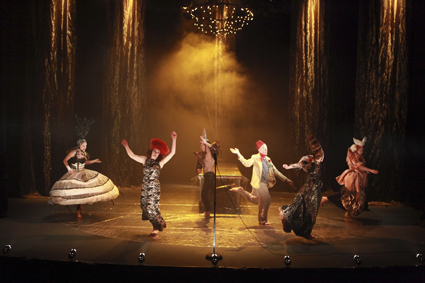critical acts of forgiveness
zsuzsanna soboslay: little dove theatre, cordelia—tell me how you love me

Cordelia, Little Dove Theatre
photo Col Bennets
Cordelia, Little Dove Theatre
SHAKESPEARE’S KING LEAR IS A PLAY ABOUT BEGETTING. LEAR AND HIS WIFE BEGET THREE DAUGHTERS; HIS PREFERENTIAL TREATMENT OF THEM BEGETS JEALOUSY AND DECEIT AND DISTORTS ALL THE FAMILY’S RELATIONSHIPS. THE PLAY’S OPENING SCENE, WHERE THE AGING LEAR DEMANDS TESTAMENTS OF LOYALTY AND DIVIDES HIS LANDS ACCORDINGLY, IS DRIVEN BY NARCISSISM AND RIDDEN WITH INJUSTICE.
The young Canberra company Little Dove use this scenario as the starting point for their explorations into family and ‘love,’ working backwards from it in a series of scenes exploring the clan’s history and rivalries. The King of France introduces the play with a sense of aloof whimsy, asserting that he fell for the youngest daughter, Cordelia, for her laugh and her ability to resist conforming with her father’s court. It is a confused role for the narrator/scene setter: asserting his own character (which is a secondary one, at best), inadequately contextualising Shakespeare’s play for those who don’t know it, and trying to set the scene for what follows.
A series of scenes unfold, tracing Cordelia’s violent birth (which killed her mother) through to sibling jealousies and the girls’ play-acting of their relationships to the truculent father. There are several serious disjunctions between text and scene-making, between an idea and its illustration or fulfilment on stage. These are elements working at odds. The performance lifts when middle sister Regan (Peta Ward), atop the regal dining table, play-acts her father, demanding his daughter’s love.
The success of this scene is in part attributable to Ward’s fine skills as an actor: her gradation of emotion and vocal quality, her subtle understanding of drives, objectives and subtexts are excellent. As a piece of direction and design, too, the scene works: this tripod of daughters with their conflicting emotions threatens to balance or unbalance the whole family structure.
Mostly, however, a burning fury takes each scene by the throat, strangling most emotions that are not rage. The characters appear as locked into their patterns as they are locked into certain repetitive, jabbing dance moves (which I take it are meant to show the conformity of the court but which dull when so prolonged).
That said, the penultimate scene, where performers relentlessly jump on the spot, is strong because something has to break—their breath, their bodies, their collective conscience. But the dramaturgy is weak. The final scene, potentially the greatest, instead reveals the inherent coldness of the production overall.
The scene is an ironic inversion of the source. In King Lear, the old king staggers from backstage, carrying the dead weight of his daughter’s body. He recognises her death as the direct result of his greed and power-mongering. His grief and guilt are deeply felt, hot-blooded. In Little Dove’s production, we see Cordelia carry the body of her mother from back to front stage. But this Mother is hard to care about: throughout, she has been a remote figure, detachedly (or drunkenly?) watching scenes unfold, stumbling in high-heels, concerned with the raunchiness of her voice but consistently ignoring her children. So the high point is the low point: who is this woman (and energy) here eulogised?
This production remains a play about pain and hatred, about palace “dance parties” (and perhaps conformist dance moves) that sublimate tragedies and tensions, but is not about ‘love’—as the director insists—or the vulnerabilities and wounds against love which lead to violence and violation.
Undoubtedly there are some strong elements at play. There is the mellifluous work of the Imp or Fool (Davie), who unfolds, appears and disappears like the smoke of someone’s conscience. The sound design by Kimmo Vennonen is eerily provocative. There is tremendous force and potential in the costume and set design by Imogen Keen, which I sense are both underutilised. But Field (Goneril) and Rotem (as Cordelia) are, sadly, strong forces directed at relentless pitch, something that diminishes the power of the performances.
Draining the play’s force severely is the structure of the second half. It proceeds through a sequence of popular songs (This Mortal Coil? Split Enz? and others not easy to identify) to which the cast essentially perform karaoke mime. It makes for a long 45 minutes, and, to my mind, it is a very serious issue for half a production to rely on, and presume to build its own emotional power out of works by uncited artists.
Critical reviews of Little Dove’s previous, outdoor performance piece, Six Women Standing In Front Of A White Wall (see RT Studio), noted its clarity of ideas and inter-relationships. Cordelia warrants similar breath and thoughtfulness to harness its forces.
Little Dove Theatre, Cordelia—tell me how you love me, director Chenoeh Miller, performers Rowan Davie, Erica Field, Hadley, Noa Rotem, Peta Ward, Janine Watson, design Imogen Keen, lighting Hartley TA Kemp, choreographer Cristina de Mello, poetry Jenny Morris, sound Kimmo Vennonen, producer Dave Sleswick/Motherboard Productions; Street Theatre, Canberra, Nov 3-5, 2011
RealTime issue #107 Feb-March 2012 pg. 37






